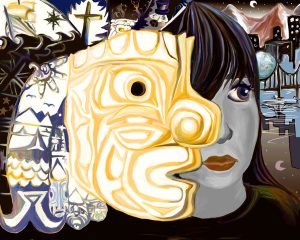Salutations to everyone,
We are about to embark on an inspiring term of learning. I’m Sarah Keller and I will be the host of this blogged adventure in Canadian literature. Before we get started though, I should tell you a bit about myself.
 I’m in my last semester of a history degree which has taken me a very long eight years to complete. In that time I’ve also completed a certification in cosmetology (hair design), and I’ve gotten various marine certifications to start a water taxi and diving business which my partner and I have run from Ruxton Island in the Gulf Islands for three summers so far. Let’s just say that I wasn’t interested in a desk job when I started my degree, and it’s only now that I’ve realized that not all arts degrees lead to desk jobs. My hobbies include graphic design, comic book illustration, creative writing, and crochet. —- Ironically those are all stationary activities that take place at desks or in chairs. (The person in the self portrait is me, by the way…. I’m not the pigeon.)
I’m in my last semester of a history degree which has taken me a very long eight years to complete. In that time I’ve also completed a certification in cosmetology (hair design), and I’ve gotten various marine certifications to start a water taxi and diving business which my partner and I have run from Ruxton Island in the Gulf Islands for three summers so far. Let’s just say that I wasn’t interested in a desk job when I started my degree, and it’s only now that I’ve realized that not all arts degrees lead to desk jobs. My hobbies include graphic design, comic book illustration, creative writing, and crochet. —- Ironically those are all stationary activities that take place at desks or in chairs. (The person in the self portrait is me, by the way…. I’m not the pigeon.)
My expectations for English 470 are that as a class we will use critical thinking to distinguish between the voices and cultures that make up Canadian literature. We will read books, stories, and articles with themes in Indigenous identity the other cultural identities that make up Canadian identity. We will also examine how stories have shaped the many cultures of Canada. I suppose that there will have to be some historical analysis in there somewhere too because Canadian cultures have changed over time, just like how stories change over time as they move from person to person, from generation to generation.
One of my favorite Canadian stories is from a friend of mine, Sarah Ling, who took hən̓q̓əmin̓əm̓ with me a few years ago. She wrote a children’s book called “Let’s Take A Walk” with help from Musqueam elder, Larry Grant, whom the story is written about. It displays Larry’s many identities because while he is a member of the Musqueam Indian band, he is also Chinese, and grew up in Canada. The multiple languages in the book show his many identities. It is a very good example of post colonial literature that is accessible to everyone, including children.
Some day soon I hope to contribute my own works to Canadian literature, although they probably will not be as deep as anything that we read in this course. The first of my many plans to do after I finish my degree is to co-write and illustrate a book with my father which we’ve been orally making stories for since I was a child. They have a great deal to do with identity, the land where one lives, and security of culture. I’m more embarrassed of my writing than my drawing so instead of linking you one of my stories, I’ll post for you a picture that I drew in 2012 that has a bit more to do with this course. It is titled “Identity”, and it has to do with the many identities of indigenous peoples in Canada.

I hope that all of you have a wonderful semester, and it will be great to read and respond to your writing.
Your fellow enthusiastic student,
Sarah Keller
Works Cited:
Elder Larry Grant, First Nations and Endangered Language Program, http://fnel.arts.ubc.ca/profiles/elder-larry-grant/ Accessed September 9, 2016.
Sarah Ling. Twitter. https://pbs.twimg.com/media/BXcHxeGCUAAdsCY.jpg:large Accessed September 9, 2016.
Sarah Keller, “Identity” . Jpeg Image. 2012.
Sarah Keller, “Me & The Pigeon”. Jpeg Image. 2012.
